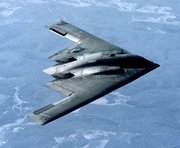Stealth aircraft
|
|

A stealth aircraft is an aircraft which has been designed to absorb and deflect radar (via stealth technology); these are not completely "invisible" to radar, they are simply harder to detect than conventional technology. In general the goal is to allow a stealth aircraft to execute its attack while still outside the ability of the opposing system's detection. Stealth aircraft were most notably used during the Gulf War (1990); although stealth technology has since become less effective, both the United States and Russia continue to develop stealth aircraft.
The main method stealth aircraft use to avoid detection is by using a body shape that deflects radar signals in a direction roughly perpendicular from the radar signals origin, rather than reflecting the signal back to enemy radar sensors. To a lesser extent, they also use a covering of some type of radar absorbing material. Stealth aircraft are also harder to detect and track via other methods (for example, infra-red signature (due to the normally hot exhaust being cooled and partially shielded from below), visually (they are painted dark, and typically fly at night), and via sound waves (they are not supersonic, they have no afterburners, and the exhaust nozzles are tuned for low noise rather than peak performance).
First-generation stealth aircraft include the F-117 Nighthawk. First-generation planes tend to be composed mostly of flat radar-deflecting surfaces that were also covered with radar absorbing materials, so as to attenuate the radar signal and deflect radar waves in a direction other than that of the radar transmitter. Second-generation aircraft include the B-2 Spirit and F-22 Raptor. The design of these aircraft benefited from sophisticated computer modeling of radar response that allowed them to incorporate curved surfaces, which are more aerodynamic than the flat surfaces on first-generation stealth aircraft.
A number of methodologies to detect stealth aircraft at long range have been developed. Both Australia and Russia have announced that they have developed processing techniques that allow them to detect the turbulence of aircraft at reasonably long ranges (possibly negating the stealth technology). The UK has announced a system that uses the signals broadcast from the huge number of cellular telephone towers to generate a synthetic picture, although it is not clear if this method is actually practical. A general feature of these systems is that they use a large number of low-accuracy radar systems (or signal sources) combined with heavy computer processing to generate tracking information. For this reason they tend to be useful only in the early warning role, and have limited applicability to guidance radars for missile systems, and are rarely portable. The problem of successfully countering stealth aircraft on the battlefield remains essentially unsolved.
| Contents |
Use of stealth aircraft
To date, stealth aircraft have been used in several low- and moderate-intensity conflicts, including Operation Desert Storm, Operation Allied Force and the 2003 invasion of Iraq. In each case they were employed to strike high-value targets which were either out of range of conventional aircraft in the theater or which were too heavily defended for conventional aircraft to strike without a high risk of loss. In addition, because the stealth aircraft aren't going to be dodging SAMs and AAA over the target they can aim more carefully and thus are more likely to hit the target and not cause as much collateral damage. In many cases they were used to hit the high value targets early in the campaign (or even before it), before other aircraft had the opportunity to degrade the opposing air defence to the point where other aircraft had a good chance of reaching those critical targets.
Stealth aircraft in future low- and moderate-intensity conflicts are likely to have similar roles. However, given the increasing prevalence of excellent Russian-built surface-to-air missile systems on the open market (such as the SA-10, SA-12 and SA-20 (S-300P/V/PMU) and SA-15 (9K331/332)), stealth aircraft are likely to be very important in a high-intensity conflict in order to gain and maintain air supremacy, especially to the United States who are likely to face these types of systems. It is possible to cover one's airspace with so many air defences with such long range and capability that conventional aircraft would find it very difficult "clearing the way" for deeper strikes. For example, China license-builds all of the previously mentioned SAM systems in quantity and would be able to heavily defend important strategic and tactical targets in the event of some kind of conflict, for example if there were another Korean war and China decided to intervene. Even if anti-radiation weapons are used in an attempt to destroy the SAM radars of such systems, or stand-off weapons are launched against them, these modern surface-to-air missile batteries are capable of shooting down weapons fired against them! The surprise of a stealth attack, and the ability to penetrate the air defences and survive, may become the only reasonable way of making a safe corridor through which conventional bombers and other aircraft can enter the enemy's airspace. Once stealth attacks from the smaller stealth force have neutralised the most serious of the SAM systems, the larger conventional or simply less-stealthy force should be able to suppress the remaining systems and gain air superiority.
List of manned stealth aircraft
- A-12 Avenger II - McDonnel-Douglas / General Dynamics (cancelled)
- B-2 Spirit - Northrop-Grumman (in service)
- F-35 Joint Strike Fighter - Lockheed-Martin (under development)
- Bird of Prey - Boeing (technology demonstrator)
- F-117 Nighthawk - Lockheed (in service)
- F/A-22 Raptor - Lockheed-Martin / Boeing (entering service)
- Have Blue - Lockheed (developed into F-117)
- Tacit Blue - Northrop (technology demonstrator)
- YF-23 Black Widow II - Northrop / McDonnel-Douglas (prototype built, lost competition to YF-22)
List of unmanned stealth aircraft
- RQ-3 Dark Star - Lockheed / Skunk Works (cancelled)
